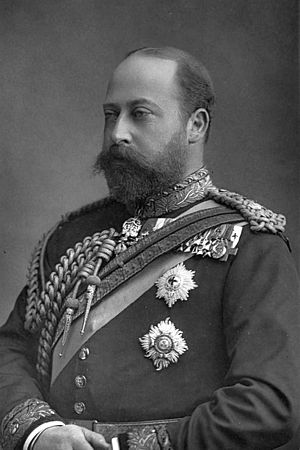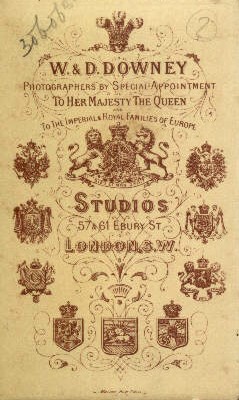- This page was last modified on 17 October 2025, at 10:18. Suggest an edit.
W. & D. Downey facts for kids

A photo of Edward VII when he was the Prince of Wales, taken by W. & D. Downey in the 1880s.
W. & D. Downey was a famous photography studio in London during the Victorian era, from the 1860s to the 1910s. They were known for taking pictures of important people, including royalty.
Contents
The Story of W. & D. Downey
William Downey (born 1829, died 1915) was a very famous photographer. People even called him "the Queen's Photographer." He was born in South Shields before photography became a common business.
William first worked as a carpenter and boat builder. Around 1855, he started a photography studio in South Shields with his brother, Daniel Downey (born 1831, died 1881). They later opened more studios in places like Blyth, Morpeth, and Newcastle.
Early Royal Photos
Their first special job for the Royal Family was in January 1862. Queen Victoria asked them to take pictures after the Hartley Colliery Disaster. This was a very sad mining accident.
In 1863, the brothers opened a studio in Newcastle. William also set up a studio inside the Houses of Parliament in London that same year. He took pictures of every person who was a Member of Parliament at that time.
William moved to London in 1872 and opened another studio there. His brother Daniel continued to manage the Newcastle studio. The London studio became very popular with Queen Victoria and the Prince of Wales. The brothers took photos at royal homes like Balmoral and Frogmore in the 1860s.
Their first royal picture was of the Princess of Wales in 1865. They also took a famous picture of the Princess of Wales giving a piggyback ride to Princess Louise. In 1879, the studio received a Royal Warrant. This meant they were officially chosen photographers for the Royal Family.
Photography Techniques
The Downey studio used a special method called the "carbon process" for their best pictures. This helped make their photos look very good. In the 1880s, a company in Newcastle made many photographic dry plates. These plates made photography much easier for businesses.
George Eastman, who later invented the Box Brownie camera and roll film, spent time there. His inventions made it possible for more people to take their own pictures. This changed how photography studios worked.
A Family Business
William Downey's son, William Edward Downey (born 1855, died 1908), took most of the royal pictures for the London studio. This was during the Edwardian era.
Gladys Cooper, who was a child model at the time, wrote about the Downeys in her book:
I remember the Downeys well – they were father and son. "Old" Downey was a very tall man with a long white beard. He always wore a long coat with a red ribbon. He looked like a very important gentleman. He knew how to greet kings and queens with the right respect. It was a great honor to have "Old" Downey take your picture. He only photographed princesses or duchesses. His staff treated him like royalty. When he rode in his carriage, they would stand around with blankets and pillows for him.
"Young" Downey (that's what they called the son) was a big man with a bald head. He was a true artist. He always knew the best side of someone's face just by looking at them. He took many beautiful pictures of the famous women of his time. He was good at showing their true personality in the photos.
I really enjoyed visiting the Downey studio. "Young" Downey loved children. My sisters and I had lots of fun playing in the big studio. We would dress up in all the amazing clothes he kept there.
The Downey Family
William Fowler Downey (the older William) married Caroline Griffiths. They had two sons, William Edward and Robert Ingham. Sadly, Robert died when he was a baby. Caroline passed away in 1874.
William married again in 1877 to Lucy Lyon. They had two children, Arthur James Hope and Laura Evelyn Downey.
William's youngest son, Arthur, continued the family photography business. In 1910, he took a picture of King George V's children. This was the same year the king became ruler.
William's brother Daniel also got married. He married Elizabeth Smith Beloe in 1863. She was the daughter of a music professor. They had three children: Robert Ingham Downey, Elizabeth, and Victoria Christine. Elizabeth, their mother, died in 1873 when she was 40 years old.
Daniel married a second time in 1876 to Mary Stratford. Daniel passed away in 1881. His wife Mary lived until 1948.

